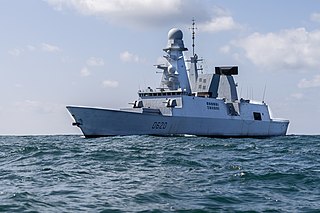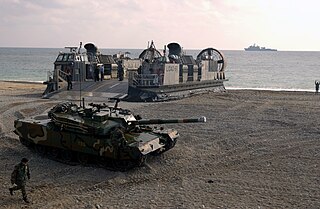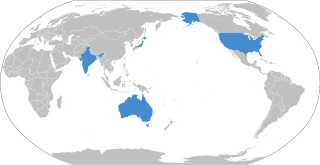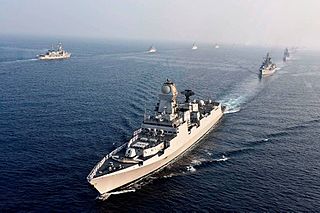Related Research Articles

The People's Liberation Army Navy, also known as the People's Navy, Chinese Navy, or PLA Navy, is the maritime service branch of the People's Liberation Army, and the naval power with the largest amount of ships in the world.

USS Ronald Reagan (CVN-76) is a Nimitz-class, nuclear-powered supercarrier in the service of the United States Navy. The ninth ship of her class, she is named in honor of Ronald W. Reagan, President of the United States from 1981 to 1989. She was built at Newport News Shipbuilding in Newport News, Virginia, and was commissioned on 12 July 2003.

HTMS Chakri Naruebet (911) is the flagship of the Royal Thai Navy (RTN), and Thailand's first and only aircraft carrier, although the RTN refers to her as an "Offshore Patrol Helicopter Carrier". Based on the Spanish Navy's Príncipe de Asturias design and constructed by Spanish shipbuilder Bazán, Chakri Naruebet was ordered in 1992, laid down in 1994, launched in 1996, and commissioned into the RTN in 1997. The ship is the smallest functioning aircraft carrier in the world.

USS Forrestal (CVA-59), was a supercarrier named after the first United States Secretary of Defense James Forrestal. Commissioned in 1955, she was the United States' first completed supercarrier, and was the lead ship of her class. The other carriers of her class were USS Saratoga, USS Ranger and USS Independence. She surpassed the World War II Japanese carrier Shinano as the largest carrier yet built, and was the first designed to support jet aircraft.

The Russian Navy is the naval arm of the Russian Armed Forces. It has existed in various forms since 1696; its present iteration was formed in January 1992 when it succeeded the Navy of the Commonwealth of Independent States.

The Indian Navy is the maritime branch of the Indian Armed Forces. The President of India is the Supreme Commander of the Indian Navy. The Chief of Naval Staff, a four-star admiral, commands the navy. As a blue-water navy, it operates significantly in the Persian Gulf Region, the Horn of Africa, the Strait of Malacca, and routinely conducts anti-piracy operations and partners with other navies in the region. It also conducts routine two to three month-long deployments in the South and East China seas as well as the western Mediterranean sea simultaneously.

Charles de Gaulle is the flagship of the French Navy. The ship, commissioned in 2001, is the tenth French aircraft carrier, the first French nuclear-powered surface vessel, and the only nuclear-powered carrier completed outside of the United States Navy. She is named after French president and general Charles de Gaulle.

Forbin (D620) is a large anti-air frigate of the French Navy, lead ship of the Horizon class. Her first task is protecting aircraft carriers, capital ships or civilian ships from supersonic missile attacks; her complement of medium-range anti-air missiles allows her to support the defences of another ship under attack and avoid their saturation. She is also capable of monitoring and controlling operations carried out from the sea by friendly aircraft. Forbin is the sixth vessel of the French Navy named after the 17th century admiral Claude Forbin-Gardanne.

Standing NATO Maritime Group One (SNMG1) is one of NATO's standing naval maritime immediate reaction forces. SNMG1 consists of four to six destroyers and frigates. Its role is to provide NATO with an immediate operational response capability.

Pyotr Velikiy is the fourth Kirov-class battlecruiser of the Russian Navy. It was initially named Yuri Andropov after the former General Secretary of the Communist Party, but the ship's name was changed after the fall of the Soviet Union. The Russian designation for the type is "heavy nuclear missile cruiser", but Western defense commentators have resurrected the term "battlecruiser" to describe them, as they are the largest surface "line of battle" warships in the world. Pyotr Velikiy is the flagship of the Northern Fleet.

USS Gravely (DDG-107) is an Arleigh Burke-class guided missile destroyer in the United States Navy. She is named after Vice Admiral Samuel L. Gravely, Jr. Commissioned in 2010, she has been on several overseas deployments.

Exercise Malabar is a naval exercise involving the United States, Japan and India as permanent partners. The annual Malabar exercises includes diverse activities, ranging from fighter combat operations from aircraft carriers through maritime interdiction operations, anti-submarine warfare, diving salvage operations, amphibious operations, counter-piracy operations, cross–deck helicopter landings and anti–air warfare operations. Over the years, the exercise has been conducted in the Philippine Sea, off the coast of Japan, the Persian Gulf, in the Bay of Bengal and the Arabian Sea. It is taken care by the Asian and the North American Commands.

Indonesia–Russia relations are the bilateral relations between Indonesia and Russia. Indonesia and the Soviet Union established diplomatic relations in 1950. Russia has an embassy in Jakarta, and Indonesia has an embassy in Moscow along with a consulate general in Saint Petersburg. Both countries are members of the APEC and G-20.

Destroyer Squadron ONE, also known as Destroyer Squadron 1 and often abbreviated at DESRON ONE or DESRON 1, is a squadron of warships of the United States Navy. It is an operational component of Carrier Strike Group One and is administratively responsible to Commander, Naval Surface Forces Pacific.

Foal Eagle is a combined field training exercise (FTX) conducted annually by the Republic of Korea Armed Forces and the United States Armed Forces under the auspices of the Combined Forces Command. It is one of the largest military exercises conducted annually in the world. Foal Eagle has been a source of friction with the government of Democratic People's Republic of Korea (DPRK) and domestic ROK critics.

The Quadrilateral Security Dialogue (QSD), commonly known as the Quad, is a strategic security dialogue between Australia, India, Japan and the United States that is maintained by talks between member countries. The dialogue was initiated in 2007 by Japanese Prime Minister Shinzo Abe, with the support of Australian Prime Minister John Howard, Indian Prime Minister Manmohan Singh and U.S. Vice President Dick Cheney. The dialogue was paralleled by joint military exercises of an unprecedented scale, titled Exercise Malabar. The diplomatic and military arrangement was widely viewed as a response to increased Chinese economic and military power, and the Chinese government responded to the Quadrilateral dialogue by issuing formal diplomatic protests to its members, calling it "Asian NATO"; Indian Foreign Minister S. Jaishankar denies China's allegations and claimed India never had ‘NATO mentality’.

Carrier Strike Group Seven 2004–2006 operations included one deployments to the U.S. Fifth Fleet, and its embarked carrier air wing flew approximately 2940 air sorties in support of ground forces in Iraq and Afghanistan while CARSTRKGRU-7 surface warships supported theater security and maritime interdiction operation within that fleet's area of responsibility. It also participated in Valiant Shield 2006, a major joint military exercise of the U.S. Pacific Command. Finally, Carrier Strike Group Seven provided humanitarian assistance after the 2004 Indian Ocean earthquake. Prior to being re-designated as Carrier Strike Group Seven on 1 October 2004, Carrier Group Seven (CarGru-7) and its John C. Stennis Carrier Battle Group participated in three different exercises during Summer Pulse 2004, a multi-carrier surge deployment to test the U.S. Navy's then-new Fleet Response Plan.

INS Shakti (A57) (Strength) is a Deepak-class fleet tanker in service with the Indian Navy. She was built by Fincantieri, an Italian shipbuilding company based in Trieste. She is the second and final ship of her class. Shakti, along with her predecessor Deepak, is one of the largest ships of the Indian Navy.
Military exercises are conducted by the Pakistan Armed Forces to increase combat readiness, and to identify problems in logistics, training, and current military doctrine. They also test the ability of units to work together. Lastly, they act as a visible expression of military might, which acts as a deterrent to potential enemy action. An important component of each exercise is the after-action assessment. Since 1989 the four branches services have increasingly begun coordinated exercises.

International Fleet Review 2016 was an international maritime exercise hosted and conducted by the Indian Navy on behalf of the President of India in February 2016 to improve relations with other navies in the region. The Indian Navy demonstrated its maritime capabilities to the foreign navies participating in the review.
References
- ↑ "United States Navy > Press Office > News-Stories". www.navy.mil. Retrieved 2022-12-15.
- ↑ "Coast Guard and NAMSI partners take part in PASSEX in San Diego". DVIDS. Retrieved 2022-12-15.